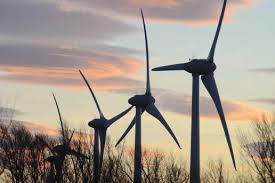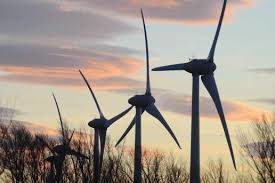 Wind Turbine Syndrome is the name given to the range of illnesses reported by a small group of people who live close to wind turbine farms. There is a long list of symptoms of wind turbine syndrome include tinnitus, dizziness, heart-palpitations, nausea, tingling, loss of sleep.A data base of symptoms kept by Simon Chapman, Professor of Public Health in Australia now lists 184 different conditions thought by their sufferers to be caused by living close to wind turbines.
Wind Turbine Syndrome is the name given to the range of illnesses reported by a small group of people who live close to wind turbine farms. There is a long list of symptoms of wind turbine syndrome include tinnitus, dizziness, heart-palpitations, nausea, tingling, loss of sleep.A data base of symptoms kept by Simon Chapman, Professor of Public Health in Australia now lists 184 different conditions thought by their sufferers to be caused by living close to wind turbines.
The term Wind Turbine Syndrome was first used by Dr Nina Pierpont, a US based pediatrician n her book published in 2009, aptly named Wind Turbine Syndrome. Dr Pierpont based her findings on phone interviews with 23 people who responded to advertisements she placed near wind farms. Anecdotal evidence was further taken from 15 other people referred to Dr Pierpont by the original self selected group of 23. So in total the sample size for the study was 38 people. No physical examinations were made of this self selected group of people who linked living near wind farms to their health problems. From these interviews she concluded that turbine infrasound and low frequency noise (ILFN) create the seemingly incongruous constellation of symptoms she christened Wind Turbine Syndrome.
Since publication Dr Pierpont’s methodology and findings have been widely criticised by the scientific community. The US base web site Checksandbalancesproject.org have brought together the key five flaws in Pierpont’s research.
“Experts dispute the premise of Pierpont’s theory.
- A panel of medical doctors, audiologists and acoustical professionals – including Dr. Robert J. McCunney of MIT – concluded, “There is no evidence that the sounds, nor the sub-audible vibrations, emitted by wind turbines have any direct adverse physiological effects on humans.“ (Expert Panel Review, 2009)
Pierpont used a sample size that was not valid.
- Pierpont’s study included just 38 people in 5 counties who at some point lived near wind turbines. “[N]o conclusions on the health impact of wind turbines can be drawn from Pierpont’s work due to methodological limitations including small sample size, lack of exposure data, lack of controls and selection bias.” (Dr. Arlene King, Ontario Chief Medical Officer of Health, 2010)
Pierpont did not see her “subjects” in person nor did she medically examine them.
- Pierpoint interviewed all her subjects over the phone and did not medically examine any of them, nor did she access their medical records. (Simon Chapman, professor of public health at the University of Sydney)
Pierpont’s work was not properly peer reviewed.
- Pierpont’s work was never properly peer reviewed, as she claims. Instead, “she showed [her work] to people she selected and then published some of their responses, including that by Oxford University’s Lord Robert May, whose subsequent public silence on the issue may suggest a re-think.”Without proper peer review, it is difficult if not impossible to assess the validity of claimed scientific findings. (Australia’s National Health and Medical Research Council, 2010)
There were no recorded complaints from anyone else.
- There is no record of complaints or symptoms of so-called “Wind Turbine Syndrome” from owners of the land on which the turbines actually sit. (TreeHugger, 2011)”
Source https://checksandbalancesproject.org/nina-pierpont/
There appears to be no scientific evidence that Wind Turbine Syndrome actually exists as a physical effect of wind turbines. That does not mean however that people get sick becuase of the presence of wind turbines near their houses.
A study, snappily entitled “Health complaints and wind turbines: The efficacy of explaining the nocebo response to reduce symptom reporting.” Did a study to investigate “A number of people are reporting an environmental sensitivity to sub-audible wind farm sound (infrasound), characterised by the experience of recurrent non-specific symptoms. A causal link between exposure and symptoms is not indicated by empirical evidence. Research indicates symptoms may be explained by the nocebo response, whereby health concerns and negative expectations, created from social discourse and media reports, trigger symptom reporting.”
They concluded “Results indicate that providing an explanation of the nocebo response, followed by exposure to infrasound, has the potential to operate as an intervention to reduce symptomatic experiences in people reporting symptoms attributed to wind farm generated infrasound.”
A nocebo response is a phrase used in drug trials when the real drug is given to some users and a placebo is given to others, the nocebo response refers to those users who report ill effects from taking the placebo. That is imagined effects.
In English I read that as people who think wind turbines syndrome exists are more likely to blame any physical and mental illness, real or not, on wind turbine syndrome if they live near wind turbines.
Does all of that mean wind turbines are not dangerous? No, not absolutely, just that there is no empirical evidence that has yet been found showing that they are. Like all new technologies further research on their impact needs to be carried out on an on-going basis by scientists, with a proper reviewed process in place. What we do know is that what is called wind turbine syndrome has no scientific basis.

